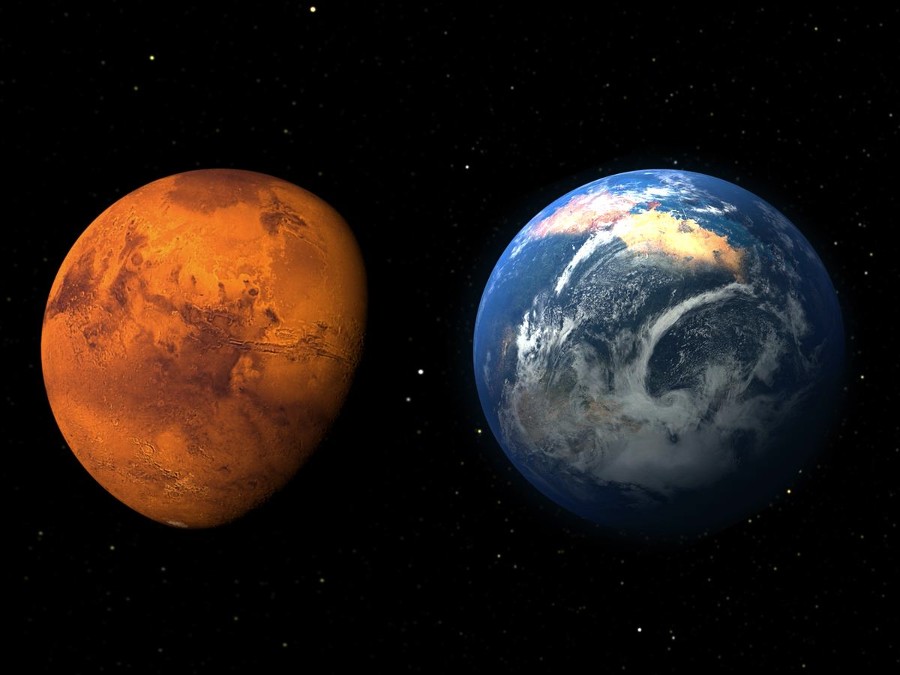The Mystery Of The Red Planet: How Far Away Is Mars From Earth And How Long Will It Take To Get There
12th Aug 2022
The secrets of Mars have long haunted humanity. The first studies of the red planet, named after the Roman god of war, supposedly began 3,500 years ago, but only with the development of technology and the ability to send robotic missions into space, did scientists get a real idea of Mars. Today we know that it has water, an atmosphere, and even organic matter. All this makes Mars hypothetically suitable for human colonization. But besides the technical difficulties of sending people to Mars, there is another one — the distance. Let’s find out how far Mars is from Earth and how long it will take to fly there.
Where is Mars in the sky?
Mars, like other planets, is constantly moving, so its position in the sky changes. In a sense, we got lucky. On August 9, 2022, Mars moved from the constellation Aries to the constellation Taurus, which lies in the Northern Hemisphere of the celestial sphere, and now we can observe its red dot even with the naked eye. Mars will remain in Taurus until the end of the year, looping around the star Aldebaran. By the beginning of winter, the visible diameter and brightness of the planet will reach a maximum, and throughout December 2022 it will be visible all night long. With a telescope we will be able to observe numerous details of the surface, as long as a sandstorm does not interfere.
Is Mars Closer to the Sun than Earth?
Earth is the third planet from the Sun, and Mars is the fourth; Mars’s distance from the Sun is one and a half times greater than from Earth and is 227 433 646 kilometres (141,320,716 miles). However, this is an average figure. Because both Mars and Earth revolve around the Sun in elliptical orbits, Mars’ perihelion (nearest point to the Sun) is 128 million miles (205 996 032 kilometres), and aphelion (farthest from the Sun): is 150 million miles (241 401 600 kilometres). Also, Mars makes one complete turn around the Sun, in roughly the time it takes for the Earth to go around twice. More precisely, an astronomic year on Mars lasts 687 Earth days or 669 sols (Martian days are equal to 24 hours 39 minutes 35 seconds).
How many miles is Earth from Mars?
There is no single answer to this question, since the distance from Earth to Mars is not a constant value. Theoretically, the Red Planet will be closest to the Earth when it reaches perihelion, and the Earth is at aphelion. Scientists call this state ‘opposition.’ In this position, the planets would be at a 33.8-million-mile (54.4 million kilometres) distance from each other. How far is that on a terrestrial scale? Like travelling from Glasgow to London and back 41,000 times, which would take you 65 years.
If Mars and Earth are both located at aphelion on opposite sides of the Sun, that is, at the maximum distance from each other, the distance between them will be 249 million miles. So, the average distance Earth to Mars is 140 million miles.
Who was the first to calculate the distance from Earth to Mars
The first person to answer the question of how far away is Mars was the Italian astronomer and engineer Giovanni Domenico Cassini. In 1672, he calculated the distance from Earth to Mars using the parallax method. The astronomer agreed with his friend Jean Richer that they would calculate from two different points — Cassini, while in Paris, and Richer in French Guiana. The experiment was carried out when the planets were closest to each other. The calculations turned out to be impressive for that time — Cassini was off by only 7%.
How far is Mars from Earth in light years
The answer to this question is simple, since light travels in a straight line, and its speed in space is a constant (300 km/s). Thus, the sun’s rays reflected from the surface of Mars, in order to reach the Earth, will need:
- Around three minutes — when Earth is closest to Mars,
- 12 minutes — at an average distance;
- 22 minutes — when Mars is farthest from Earth.
It is quite difficult to calculate the flight time of a spacecraft since it depends on multiple conditions.
How long does it take to get to Mars from Earth in years?

Robotic mission statistics dating back to 1964 show that the time it takes a spacecraft to travel the distance to Mars varies from 128 (Mariner 7, 1969) to 333 days (Viking 2, 1975). Why such a difference?
According to NASA, Mars approaches the Earth approximately every 26 months — the same time at which oppositions occur. This time is the best time to launch spacecraft to Mars. However, one has to remember that, first, the planets are constantly in motion, which is why Mars’ distance from Earth changes all the time; and second, a spacecraft on a direct path to Mars will need to spend much more fuel.
That is why it is better to launch in a certain orbit, gradually bringing the spacecraft closer to the planet. The gravitational field of the Sun will pick up the spacecraft and accelerate it. This method is called a gravitational maneuver. At a pre-calculated moment, the spacecraft will leave the gravitational field of the Sun and enter the orbit of Mars.
How many miles is Earth from Mars if flying on different trajectories
There are only three trajectories for flights to Mars:
- Hohmann (around 260 days). Most commonly used for robotic missions. The ship starts from Earth, passing a half segment of an elliptical trajectory until it coincides with the Martian orbit.
- Parabolic — 80 days. This path to Mars is the shortest and is a half-segment of a parabola. The downside is that the spacecraft must be accelerated to escape the Sun’s gravity – 16.7 km / s, which will require four times more fuel in a Hohmann orbit.
- Hyperbolic. It was along this trajectory that the New Horizons probe was launched in 2006 to Pluto. It crossed the orbit of Mars in 78 days, which was the shortest flight to the red planet.
How long will it take Elon Musk to get to Mars?
So, we determined how long it takes satellites and light to reach Mars, but how many years will it take humans to go to Mars? A few years ago, there was no clear answer to this question. And the flights to Mars themselves were only dreams at the level of the Mars One project until SpaceX founder Elon Musk announced his plans to colonize Mars. Every indication is that this is not an empty promise.
The company is actively working on the creation of a reusable Starship spacecraft for transporting people and cargo to Mars. The ship will use liquid methane, which can be mined on Mars, as fuel, and support multiple refuelling in space and on the planet so that it can return to Earth. Returning to Earth from Mars was previously considered impossible due to a lack of fuel for the return journey. Until now, a flight to Mars had been considered a one-way ticket.
Starship stands every chance of solving this problem. That is one of the primary reason why NASA chose Spaceship for its new lunar program Artemis, which aims to create a permanent base on the Moon. By the way, this base will also serve as a launch pad for flights to Mars, which will significantly reduce the complexity and time of expeditions. But while Artemis is still in the works, Musk is not abandoning his plans to go to Mars from Earth.
How long will it take a SpaceX Starship to get to Mars? Here is the flight plan
After reaching the Hohmann trajectory, the flight and landing on the red planet will take about 115 days. Let’s take a closer look at how SpaceX plans to get the spacecraft to this starting point.
The Super Heavy launch vehicle accelerates the Starship to a speed of 8650 km / h and returns to Earth after undocking. The spacecraft continues its flight until it reaches the parking orbit, where it waits for the tanker ship. The tanker is launched on the returned booster to dock with and refuel the main ship. The tanker then returns to the launch pad to repeat the operations. In total, it will take up to five refuelings to overcome the distance to Mars. Next, the interplanetary spacecraft uses vacuum engines at a speed of 6 km/s to enter the Hohmann trajectory. Fuelled by Mars-produced fuel, the ship can launch back to Earth using only its own engines, without a booster, due to the relatively low escape velocity for Mars (5 km/s versus 11.2 km/s for Earth).
Conclusion
Having learned how far is Mars from Earth and how to get there, you may wonder what we would do there. Conditions on the planet are extremely hostile. It is half the diameter of the Earth and 10 times lighter, the rarefied atmosphere of Mars is unbreathable, the pressure is 160 times less than Earth’s, the climate is changeable, and dust storms sometimes almost completely hide the surface of the planet and can last for months. And yet the Red Planet is the only possible “alternate airfield” for humanity in case of evacuation. After all, who knows how much more violence against itself the blue planet can withstand?






Thank you for your comment! It will be visible on the site after moderation.